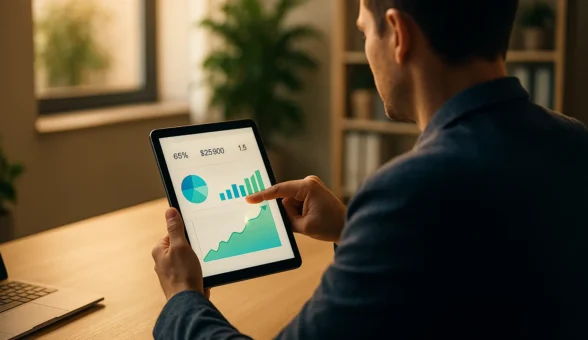
Dashboard Indicators: Steer Your SME Effectively
Struggling to turn your business data into strategic decisions? The KPI dashboard is the key tool for managing your SME with precision. Discover how to define the right Key Performance Indicators (KPIs), structure effective dashboards, and align every action with your strategic goals. From cash flow monitoring to employee satisfaction, this practical guide walks you through creating and using a dashboard tailored to your business, step-by-step.
Table of Contents
1- Understanding Dashboards and Their Indicators
2- Building an Effective Dashboard for Your Business
3- Using Management Dashboards Effectively
4- Tools and Technologies to Create High-Performance Dashboards
5- Examples and Practical Cases of Successful Dashboards
Understanding Dashboards and Their Indicators
Definition and Role of Dashboards in Business
A dashboard is a business management tool comprising performance indicators. It helps anticipate changes and facilitates decision-making. This tool summarizes key data for efficient activity monitoring.
Dashboards help you understand your company’s performance. They support decision-making through relevant indicators. These tools reduce uncertainty and stabilize information. A dashboard also contributes to communication, strategic thinking, and risk management. Our operations and organizational experts can assist you in this process.
Different Types of Indicators and Their Importance
| Function | Key Performance Indicators (KPI) |
|---|---|
| Finance | Cash flow, liquidity ratio, profit margin |
| Sales | Revenue, conversion rate, payment terms |
| Marketing | Website traffic, return on investment (ROI), number of leads |
| Production | Costs, average lead time, quality |
| Human Resources | Employee satisfaction, turnover rate, absenteeism |
Relevant indicators guide the business and facilitate informed decision-making. Their selection must align with the overall strategy. More than 25 key indicators can be used to measure a company’s performance. These indicators should reflect the unique characteristics of each organization for effective management. Strategic alignment ensures that measurement efforts contribute to business objectives.
Building an Effective Dashboard for Your Business
Identify Objectives and Choose Key Indicators
Defining strategic objectives guides the selection of relevant indicators. Without this step, your data may end up disorganized. Align your KPIs (Key Performance Indicators) with your short- and long-term goals for consistent business management.
The selection criteria for indicators vary depending on the sector and size of the business. An SME prioritizes simple, quick-to-measure KPIs, while a large organization may include complex indicators. The key is to stay aligned with your business goals and avoid unnecessary metrics.
Structuring and Organizing Data for Better Readability
A clear structure makes data interpretation easier. Place key indicators at the top, use visual hierarchy, and standardize measurement scales to avoid confusion.
- Key Performance Indicators (KPIs) are aligned with strategic objectives.
- Clear and intuitive visualizations for quick data reading
- Logically and thematically organized information
- Regular data updates for real-time decision-making
Presentation formats should match the nature of the data. Use line charts for time-based trends, gauges for fixed targets, and detailed tables for precise data. Visual consistency enhances the clarity of your message.

Essential Financial Indicators to Monitor
Financial indicators such as cash flow, gross margin, and working capital requirements (WCR) reflect the economic health of your business. They help anticipate financial stress and adjust strategies accordingly.
Cash flow measures liquidity, the liquidity ratio evaluates the ability to meet short-term debts, and the margin rate reflects profitability. Together, these indicators provide a comprehensive overview for informed financial decisions.
Using Management Dashboards Effectively
Best Practices for Interpreting and Using Dashboard Data
Dashboards summarize key performance indicators to facilitate decision-making. Focus on deviations from goals and identify trends to act quickly. Rigorous analysis transforms data into actionable insights aligned with your business objectives.
| Monitoring Frequency | Types of Indicators | Monitoring Objective |
|---|---|---|
| Daily | Daily revenue | Track sales in real-time and immediately identify variations |
| Daily | Conversion rate | Measure campaign effectiveness and customer journey |
| Daily | Website traffic | Analyze user engagement and digital marketing effectiveness |
| Daily | Marketing campaign performance | Optimize marketing actions in real-time |
| Weekly | Number of leads generated | Evaluate commercial development effectiveness |
| Weekly | Customer satisfaction rate | Quickly identify customer service issues |
| Weekly | Employee performance | Track productivity and team engagement |
| Monthly | Monthly revenue | Assess overall company performance |
| Monthly | Gross margin | Control profitability of products or services |
| Monthly | Expenses | Manage budget and optimize costs |
| Monthly | Net profit | Evaluate overall profitability of the company |
| Quarterly | Market share | Assess company competitive position |
| Quarterly | Return on investment (ROI) | Measure profitability of strategic investments |
| Quarterly | Customer acquisition cost (CAC) | Optimize growth strategies |
The Importance of Regular Monitoring and Adjusting Indicators Based on Business Evolution
Dynamic dashboards adapt to new challenges. Outdated indicators hinder decision-making. Review your KPIs quarterly to ensure they reflect your current priorities. This regular monitoring ensures proactive management and timely strategic adjustments.
Tools and Technologies for Creating High-Performance Dashboards
Software Solutions for Dashboard Creation
Dashboard creation software includes Excel, Power BI, Tableau, and Google Data Studio. These tools turn raw data into interactive visualizations. The choice depends on the business needs, the organization’s size, and its technical capabilities. Small and medium-sized businesses (SMBs) tend to favor lightweight solutions, whereas large organizations opt for more advanced business intelligence (BI) platforms.
Business Intelligence solutions, such as Power BI, are designed for large organizations. They incorporate predictive analysis and the exploration of complex data. SMBs prefer simpler tools, such as Excel, DashThis, or Google Data Studio. These platforms offer intuitive interfaces and pricing suited to tighter budgets. The selection depends on data volume, analytical needs, and the company’s growth outlook.
Data Integration and Dashboard Automation
Integrating multiple data sources may require tools like Power BI. ETL (Extract, Transform, Load) processes and APIs unify heterogeneous sources for coherent exploitation. This approach ensures an accurate overview and reduces information silos.
- Automation reduces human error.
- It speeds up indicator updates.
- It optimizes analysis time for the business team.s
- It improves responsiveness to market changes.
Platforms like Microsoft Fabric centralize real-time data. Excel connectors or APIs automatically integrate external sources. These technologies ensure regular updates of key indicators for faster decision-making. Cloud-based solutions enhance collaboration through synchronized access.
Security and Sharing of Dashboards Within the Organization
Protect dashboards with granular access controls. Use two-factor authentication and encrypt sensitive data. GDPR compliance governs the sharing of strategic information to prevent data leaks.
Adapt dashboard sharing to hierarchical levels. Executives access strategic KPIs, while operational teams view specific indicators. Sharing settings adjust visibility based on business roles. Tools like Tableau Server allow access rights to be assigned by user group.
Examples and Practical Cases of High-Performance Dashboards
Presentation of concrete examples of dashboards tailored to the specifics of different industries
Dashboards should reflect the unique characteristics of each industry. Effective monitoring of key indicators enables real-time adjustments to strategy, aligned with business priorities.
| Sector | Key Indicators (KPI) | Objective |
|---|---|---|
| Sales | Revenue, gross margin, customer acquisition cost (CAC) | Optimize profitability and commercial growth |
| Marketing | Number of leads, conversion rate, cost per click (CPC) | Evaluate campaign effectiveness and budget |
| Industrial | Overall Equipment Effectiveness (OEE), production costs, downtime | Improve efficiency and reduce losses |
Indicators vary depending on each organization’s needs. The commercial sector focuses on profitability, marketing tracks lead generation, and the industrial sector monitors productivity. These examples demonstrate how to tailor dashboards to your specific activity, enabling relevant strategic and operational decisions.
Effective dashboards are built on three pillars: relevant indicators, a clear structure, and suitable tools. By turning your data into strategic decisions, you enhance your company’s performance. Ready to design your dashboard and steer your business in real-time?
FAQ
How to integrate unstructured data?
Integrating unstructured data, such as text or images, begins with identifying relevant sources for your business. Next, this data must be extracted and transformed using techniques like natural language processing to structure the information.
Once structured, the data is analyzed to identify trends and visualized in the dashboard, enabling informed monitoring and decision-making. Continuous monitoring is essential to ensure data accuracy.
How to Choose the Ideal Refresh Frequency?
The ideal refresh frequency depends on the nature of the data, user needs, and technical constraints. Real-time data requires more frequent updates than monthly data, for example.
It is crucial to find a balance between the need for up-to-date information, your infrastructure’s capabilities, and how often users consult the dashboard to make decisions.
How to personalize dashboards by user?
Personalizing dashboards enables you to provide each user with relevant information. This can be done by allowing users to create their dashboards and tailor the displayed data to their specific needs.
For spatial data, effective geovisualization can be implemented. The goal is to make maps more readable and help decision-makers configure the map visualization optimally.
What are the common pitfalls to avoid in design?
Avoid information overload by focusing on the most relevant key performance indicators. Poor data visualization can be misleading, so it is crucial to choose appropriate charts.
Don’t forget to provide clear context for the data and allow view customization. Design the dashboard based on user needs and be aware of potential biases in the indicators.
How to ensure dashboard adoption?
To encourage dashboard adoption, it is essential to define clear goals and choose the right indicators. These indicators should be SMART (Specific, Measurable, Achievable, Realistic, and Time-bound).
Ensure the dashboard is user-friendly, train users on its use, and communicate regularly about the results. Continuous updates and improvements are also key.
How to use AI to improve dashboards?
AI can enhance dashboards by suggesting relevant visualizations and automating the creation of strategic dashboards. It also enables predictive analysis to anticipate future developments.
AI can personalize dashboards and automate tasks such as data collection. While useful, artificial intelligence should complement human expertise for optimal design.




